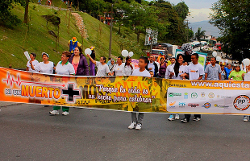Documented threats to Colombia’s human rights activists skyrocketed in 2014, pointing to efforts by shadowy interest groups to halt land restitution efforts.
Some 626 threats against human rights activists were documented in 2014, up 71 percent from 366 cases the previous year, Colombian human rights non-governmental organization (NGO) Somos Defensores said it its latest report. Armed groups looking to derail Colombia’s ongoing peace and land restitution processes were responsible for the majority of these threats, in particular the Aguilas Negras and the Rastrojos, the NGO’s Communications Director Carlos Guevara told InSight Crime.
Both the Aguilas Negras and the Rastrojos are descendants of the United Self-Defense Forces of Colombia, or the AUC by its Spanish acronym. The AUC was a loose federation of right-wing paramilitary groups formed in 1996 with the goal of fighting left-wing guerrillas like the FARC and the ELN.
On top of activities like drug trafficking and kidnapping, the AUC financed itself by seizing land and displacing Colombian civilians. Seized lands have since passed on to AUC’s descendant groups, as well as third parties working with armed groups.
According to Guevara, the AUC’s descendents and these third-party interests are now looking to intimidate Colombians and human rights activists from participating in current land restitution efforts, or any future land reform that may result from a peace deal signed with the Colombia’s largest guerrilla group the FARC. Even more concerning, Guevara alleged these groups often operate with backing from politicians and military personnel opposed to Colombia’s peace process.
Colombia’s guerrillas, who have also played a part in land seizures and civilian displacement, were also responsible for threats to human rights activists, but the majority of threats were attributed to neo-paramilitary groups, the Somos Defensores report said.
InSight Crime Analysis
The increase in documented aggression towards activists indicates the degree to which neo-paramilitaries, and their alleged backers, feel threatened by land restitution efforts. While killings of human rights activists actually dropped between 2013 and 2014, this trend could reverse as land restitution efforts continue and further impinge on land stolen by criminal groups.
Worsening the situation is a perceived atmosphere of impunity in which criminals are free to threaten and harm human rights activist without fear of repercussions. Colombia’s Prosecutor General has yet to charge a single person in connection with threats towards activists and participants in land restitution efforts. “The ongoing threats and attacks are entirely predictable given Colombia’s chronic failure to deliver justice for both current and past abuses,” Human Rights Watch (HRW) Americas Director Jose Miguel Vivanco said in a 2013 report.
Land theft and displacement have been major issues in Colombia’s long-running internal conflict, with an estimated 4.87 million people displaced between 1985 and 2013, according to HRW. Creating an environment in which victims can reclaim stolen land without being threatened by elite, criminal interests is a prerequisite for any lasting peace, and will be a true test of the Colombian government’s ability to bring about such peace.

